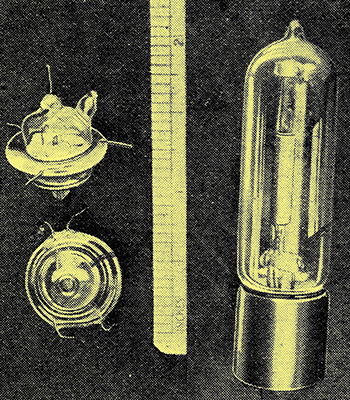|
Development of Minute Types

Two of the new valves are shown on the left. The valve on the right is a Weco peanut for comparison.
New work on the development of valves for use at wavelengths below one metre has recently been described in America.
Disregarding the generally accepted idea that to get oscillations and amplification at lower wavelengths required trick circuits with conventional valves, it was decided instead to remake the valves and use them with conventional circuits. This has now been done experimentally; to make valves work at wavelengths ten times as low as present valves, the dimensions of the valves were reduced by a factor of ten. Reducing the physical dimensions did not change the characteristics, but the inter-electrode capacities were reduced and the limiting wavelength could be taken down much lower. Designers have been successful in making valves which oscillate beautifully at I00 centimetres in well-known circuits and which oscillate without difficulty, though with less power, at 40 centimetres.
Not only will these valves oscillate - they will amplify. Thus at 100 centimetres a stage gain of about 4 with a screen grid valve is not difficult.
It sounds simple to reduce the dimensions of a valve by a factor of ten, but the problems are many. According to one correspondent the point has not been reached where these diminutive valves can be made in quantity. The tolerances between elements are so small that slight changes in geometry produce large changes in electrical characteristics. But good progress has been made: new valves working well at one metre and less have been made - and television seems nearer. For it is certain that television must go on the ultra-short wavelengths, certainly of the order of 5 metres.
|